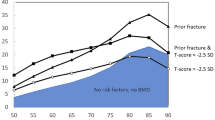Abstract
Many types of bone densitometry equipment are available in Japan, but the numbers of such machines and the numbers of institutions that offer bone densitometry have not been clarified. We analyzed the data from annual surveys conducted by the Japan Osteoporosis Foundation from 1996 to 2006, and we obtained the following results on the use of densitometry equipment: (1) In 1996 there were 6,687 units of bone densitometry equipment in 6,483 institutions in Japan; in 2006 there were 16,371 units in 15,020 institutions. (2) In 2006, of the types of institutions with bone densitometry equipment, the number of clinics was the highest, followed in order by general hospitals, other types of institutions, screening institutions and university hospitals. Rates of increase in the installation of equipment in clinics and other types of institutions were high during the 11-year period from 1996. (3) From 1996 to 2006 the region of interest most frequently used for bone densitometry was the radius. However, during the 11-year period, the proportion of radial densitometry equipment in all institutions with bone densitometry equipment decreased, whereas the proportion of calcaneal densitometry equipment increased. (4) The number of dual-energy X-ray absorptiometry (DXA) units was the highest from 1996 to 2006. However, the proportion of DXA machines in all institutions with bone densitometry equipment decreased over the 11-year period, whereas the proportion of quantitative ultrasound (QUS) machines increased. (5) In 2006, bone densitometry equipment was available in 118 institutions per million Japanese people. Central DXA (spine/hip) equipment was available in 15 per million, radial DXA equipment in 63 per million, and calcaneal QUS equipment in 44 per million. (6) In 2006, among those places with bone densitometry equipment, 46% of university hospitals, 14% of general hospitals, 12% of screening institutions, 5% of clinics, and 6% of other types of institutions possessed more than one type of densitometry equipment. (7) In 2006, central DXA (spine/hip) was frequently available in university hospitals, radial densitometry equipment in general hospitals and clinics, and calcaneal densitometry equipment in screening institutions and other types of institutions.






Similar content being viewed by others
Abbreviations
- BMD:
-
Bone mineral density
- YAM:
-
Young adult mean
- RA:
-
Radiographic absorptiometry
- DXA:
-
Dual-energy X-ray absorptiometry
- pQCT:
-
Peripheral quantitative computed tomography
- SXA:
-
Single-energy X-ray absorptiometry
- QUS:
-
Quantitative ultrasound
- DPA:
-
Dual-photon absorptiometry
References
NIH Consensus Development Panel on Osteoporosis Prevention, Diagnosis, Therapy (2001) Osteoporosis prevention, diagnosis, and therapy. JAMA 285:785–795
Orimo H, Sugioka Y, Fukunaga M, Muto Y, Hotokebuchi T, Gorai I, Nakamura T, Kushida K, Tanaka H, Ikai T, Oh-hashi Y (1998) Diagnostic criteria of primary osteoporosis. J Bone Miner Metab 16:139–150
Orimo H, Fukunaga M, Nakamura T, Shiraki M, Ohta H, Oh-hashi Y, Hosoi Y, Fujiwara S, Sakata K, Harada A, Mori S (2006) Study of actural conditions of osteoporotic fracture and research on the construction of a nationwide diagnosis and treatment database. Research summary report for end of fiscal year 2006. Subsidized by a public grant for scientific research
Ministry of Health, Labor and Welfare Secretariat, Statistics and Information Department, Japan (2006) General conditions of regional health care in fiscal year 2006, including geriatric and personal healthcare: business report. http://www.mhlw.go.jp/toukei/saikin/hw/c-hoken/06/index.html
Ohta T, Orimo H, Gorai I, Sakurai H, Suzuki T, Hirota T, Fukunaga M, Hosoi T, Miki T, Yamazaki K (2000) The osteoporosis prevention manual, 2nd edn. Japan Medical Journal, Tokyo
Ministry of Public Management, Home Affairs, Posts and Telecommunications, Japan (2006) Population, dynamic trends in population, and number of homes, based on basic resident register (31 March 2006). http://www.soumu.go.jp/c-gyousei/020918.html#si1
Pharmaceuticals and Medical Devices Agency. Web site for dissemination of medical equipment information for ethical drug package inserts. http://www.info.pmda.go.jp/psearch/html/menu_tenpu_base.html
Ott K (1998) Osteoporosis and bone densitometry. Radiol Technol 70:129–148
Webber CE (2006) Photon absorptiometry, bone densitometry and the challenge of osteoporosis. Phys Med Biol 51:R169–R185
Blake GM, Fogelman I (2001) Bone densitometry and the diagnosis of osteoporosis. Semin Nucl Med 31:69–81
Report of a WHO scientific group (2003) Prevention and management of osteoporosis. WHO Technical Report Series 921: World Health Organization Geneva
Kanis JA, Johnell O (2005) Requirements for DXA for the management of osteoporosis in Europe. Osteoporos Int 16:229–238
Brunader R, Shelton DK (2002) Radiologic bone assessment in the evaluation of osteoporosis. Am Fam Physician 65:1357–1364
Weiss M, Ben-Shlomo A, Hagag P, Ish-Shalom S (2000) Discrimination of proximal hip fracture by quantitative ultrasound measurements at the radius. Osteoporos Int 11:411–416
Bauer DC, Gluer CC, Cauley JA, Vogt TM, Ensrud KE, Genant HK, Black DM (1997) Broadband ultrasound attenuation predicts fractures strongly and independently of densitometry in older women: a prospective study. Study of osteoprotic fracture research group. Arch Intern Med 157:629–634
Hans D, Dargent-Molina P, Schott AM, Sebert JL, Cormier C, Kotzki PO, Delmas PD, Pouilles JM, Breart G, Meunier PJ (1996) Ultrasonographic heel measurements to predict hip fracture in elderly women: the EPIDOS prospective study. Lancet 348:511–514
Fujiwara S, Sone T, Yamazaki K, Yoshimura N, Nakatsuka K, Masunari N, Fujita S, Kushida K, Fukunaga M (2005) Heel bone ultrasound predicts non-spine fracture in Japanese men and women. Osteoporos Int 16:2107–2112
Acknowledgments
We are deeply grateful to Aloka Co., Ltd., Arkray Inc., Elk Co., Fujifilm Corporation, Furuno Electric Co., Ltd., GE Yokogawa Medical Systems Ltd., Hamamatsu Photonics K.K., Hitachi Medical Co., JEOL Datum Ltd., Mochida Siemens Medical Systems Co., Ltd., Nihon Kohden Co., Nippon Sigmax Co., Ltd., Stryker Japan K.K., Tanita Co., and Toyo Medic Co., Ltd., for providing information on bone densitometry equipment.
Author information
Authors and Affiliations
Corresponding author
About this article
Cite this article
Yamauchi, H., Fukunaga, M., Nishikawa, A. et al. Changes in distribution of bone densitometry equipment from 1996 to 2006 in Japan. J Bone Miner Metab 28, 60–67 (2010). https://doi.org/10.1007/s00774-009-0099-x
Received:
Accepted:
Published:
Issue Date:
DOI: https://doi.org/10.1007/s00774-009-0099-x




